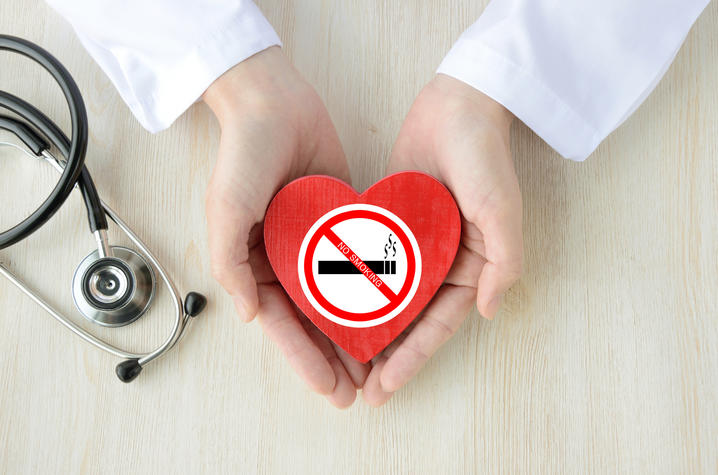The best lifestyle change to improve heart health? Quitting smoking

The University of Kentucky Public Relations and Strategic Communications Office provides a weekly health column available for use and reprint by news media. This week’s column is by Peter Haigh, M.D., a noninvasive cardiologist at UK HealthCare’s Gill Heart & Vascular Institute.
LEXINGTON, Ky. (July 14, 2025) – We have known for decades that smoking tobacco is bad your health. Quitting smoking is probably the single best change a person can make not only for prevention of heart disease, but for their overall health.
Smoking is likely the cause of one out of four deaths from heart disease, and it plays a major role in the development of atherosclerosis (plaque formation and hardening of the arteries). Smoking also is a major risk factor for more than a dozen cancers and is the cause of nine out of 10 cases of lung cancer.
Besides heart disease and cancer, smoking can also cause:
- Chronic lung disease
- Osteoporosis
- Infertility and sexual health dysfunction
- Insulin resistance
- Stomach ulcers
- Kidney failure
- Vision loss
- Gum disease
- Impaired wound healing
Secondhand smoke affects nonsmokers in the same way as smokers through inhaling the chemicals in the air. Smoking is harming not only people that choose to smoke but also those in their environment.
Smoking’s effect on the body
Smoking causes damage and inflammation in the walls of the arteries through a process called atherosclerosis, a term that describes plaque formation and hardening of the arteries.
When plaques form in the arteries of the heart, blood flow to the heart muscle is reduced. This can lead to angina (chest pain), heart failure or even heart attacks in the case of a major blockage.
Smoking causes atherosclerosis and plaque formation in all of the arteries of the body, not just those found in the heart. Plaque buildup elsewhere can lead to strokes, kidney disease, digestive issues and pain in the legs due to poor circulation.
Long term inflammation and damage from smoking can lead to many health problems including heart disease, cancer, high blood pressure and more. These problems lead to decreased longevity and impaired quality of life.
Why — and how — to quit smoking
It’s never too late to quit smoking! Within one year after quitting, a person’s risk of heart disease decreases by half. That risk reduction is stronger than just about any other single medication or intervention available.
Within one year, people typically experience an improvement in lung-related symptoms such as shortness of breath. In additional to cardiovascular disease benefits of quitting, stopping smoking also reduces the risk of over a dozen types of cancer — not just lung cancer.
Quitting smoking can seem overwhelming — or even impossible — but it is truly the best thing one can do for their health. You owe it to yourself to try. The steps to quit are: SET, CHOOSE, DECIDE, PREPARE and QUIT.
SET: Select a date when you will quit.
CHOOSE: Select a method of quitting. Will you quit completely at once (“cold turkey”) or gradually reduce your smoking before totally quitting?
DECIDE: Determine if you need help from a health care professional. People quit smoking with more success if they get help from their doctor and use nicotine replacement medications (gum, patches or lozenges) in combination with medications that reduce cravings.
PREPARE: Remove all tobacco products from your home, car or any other location they’re used. Make a plan for what you’ll do to distract yourself when nicotine cravings kick in. Some people use nicotine gum or another alternative, but you might be able to fight your craving by focusing on a favorite activity or new hobby.
QUIT: On the day you’ve decided to quit (or reduce your smoking), do it! And don’t get discouraged if you start smoking again. All of those days or weeks without cigarettes were not wasted. Remember all of the incredible health benefits you will experience through sustained quitting.
Visit quitnow.net for more information and resources on quitting, and also consider talking to your primary care provider for help.
UK HealthCare is the hospitals and clinics of the University of Kentucky. But it is so much more. It is more than 10,000 dedicated health care professionals committed to providing advanced subspecialty care for the most critically injured and ill patients from the Commonwealth and beyond. It also is the home of the state’s only National Cancer Institute (NCI)-designated Comprehensive Cancer Center, a Level IV Neonatal Intensive Care Unit that cares for the tiniest and sickest newborns and the region’s only Level 1 trauma center.
As an academic research institution, we are continuously pursuing the next generation of cures, treatments, protocols and policies. Our discoveries have the potential to change what’s medically possible within our lifetimes. Our educators and thought leaders are transforming the health care landscape as our six health professions colleges teach the next generation of doctors, nurses, pharmacists and other health care professionals, spreading the highest standards of care. UK HealthCare is the power of advanced medicine committed to creating a healthier Kentucky, now and for generations to come.




